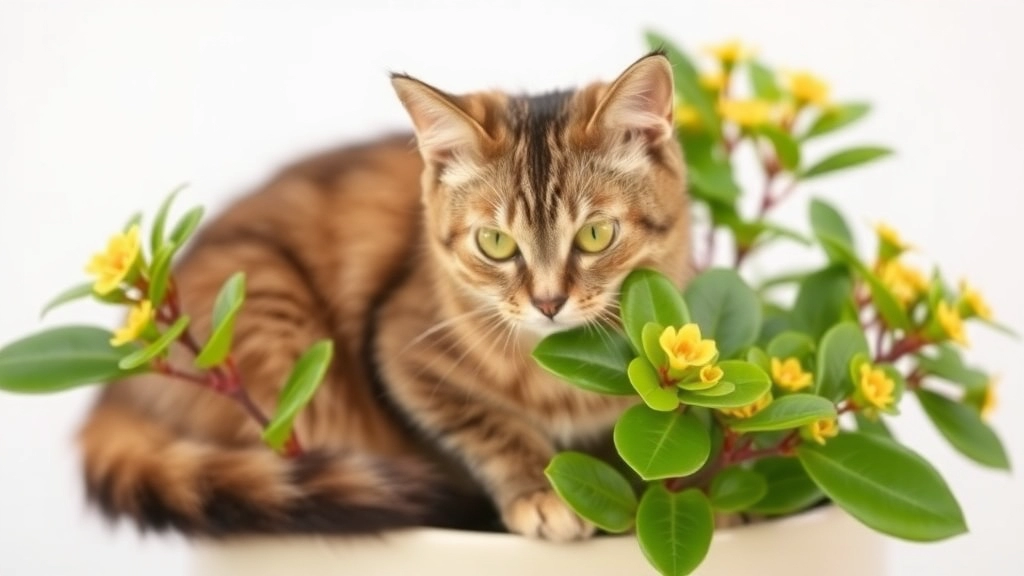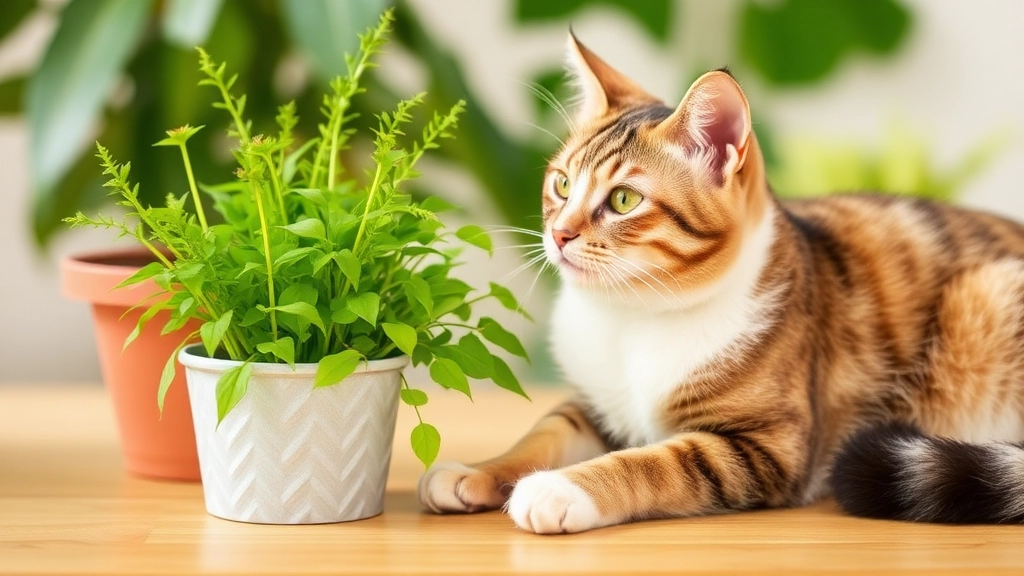Kalanchoe and Cats: Understanding the Risks
Ever wondered if the beautiful florist Kalanchoe is toxic to cats? You’re not alone. Many cat owners are concerned about the safety of their furry friends around these popular houseplants. The truth is, Kalanchoe can be harmful to cats, and knowing the symptoms of toxicity, as well as prevention tips, is crucial for any pet owner.
In this article, we’ll dive into why Kalanchoe is toxic to cats, the common signs of poisoning, and what immediate actions to take if your cat ingests this plant. We’ll also suggest safer plant alternatives and offer tips on keeping your home safe for your feline companions. Let’s ensure your cat stays healthy and happy!
Why is Kalanchoe Toxic to Cats?
As a cat owner, you might be wondering why certain plants, like Kalanchoe, pose a risk to your feline friend.
Kalanchoe is a popular houseplant known for its vibrant flowers and easy care. However, it contains compounds known as bufadienolides, which are toxic to cats. These compounds can disrupt heart function and lead to serious health issues.
Understanding the Toxicity
- Bufadienolides: These are steroid-like compounds that can affect the heart.
- Cardiac Effects: Ingesting Kalanchoe can lead to irregular heartbeats, increased heart rate, and even heart failure in severe cases.
- Other Risks: Besides cardiac issues, Kalanchoe can also cause gastrointestinal upset, leading to symptoms like vomiting and diarrhea.
Why It Matters
Recognising the toxicity of Kalanchoe is crucial for cat owners. Many people may not realise that this common houseplant can be harmful.
Being informed can help you take proactive measures to protect your cat from potential poisoning. For more detailed information on the symptoms and safety measures, you can refer to Kalanchoe Poisonous to Humans: Symptoms and Safety Tips.
If you’re looking for alternative plants that are safe for your pets, you might find our Kalanchoe Succulent Identification Guide useful.
Common Symptoms of Kalanchoe Poisoning in Cats

So, you’ve got a Kalanchoe plant and you’re worried about your feline friend? You’re not alone. Many cat owners fret over the potential dangers these lovely plants pose to their curious companions.
If your cat has nibbled on a Kalanchoe, it’s crucial to know what symptoms to look out for. Here’s what you might see:
- Vomiting: One of the first signs that something’s off. If your cat starts throwing up, it’s a red flag.
- Diarrhoea: Loose stools can indicate that your cat’s tummy is not happy.
- Lethargy: If your usually playful kitty is suddenly a couch potato, it could be a sign of poisoning.
- Drooling: Excessive drooling can be a response to nausea or irritation.
- Abdominal Pain: If your cat seems uncomfortable or is hiding more than usual, it might be in pain.
- Tremors: Shaking or twitching can occur in more severe cases.
If you notice any of these symptoms, it’s time to take action.
Immediate Steps to Take if Your Cat Ingests Kalanchoe
If you suspect your cat has ingested Kalanchoe, it’s natural to feel a surge of panic. What should you do next?
Immediate Actions:
- Stay Calm: Your cat can sense your anxiety. Take a deep breath to think clearly.
- Assess the Situation:
- Check how much your cat has eaten.
- Look for any visible symptoms.
- Contact Your Vet:
- Call your veterinarian or an emergency animal clinic immediately.
- Provide details about your cat’s size, the type of Kalanchoe, and any symptoms observed.
- Do Not Induce Vomiting:
- Unless directed by a vet, do not attempt to make your cat vomit. This could cause more harm than good.
- Monitor Symptoms:
- Keep an eye on your cat for signs such as vomiting, lethargy, or changes in appetite.
- Document any changes to share with your vet.
- Gather Information:
- If possible, take a sample of the plant to show your vet. This can help with diagnosis and treatment.
Taking these steps promptly can make a significant difference in your cat’s recovery. If you’re interested in learning more about the potential risks, you can read about Kalanchoe toxicity and safety tips. Additionally, understanding the toxicity of Kalanchoe Pink Butterflies can provide further insights.
Safe Plant Alternatives for Cat Owners

As a cat owner, finding safe plants can feel daunting, especially with the risk of toxic varieties like Kalanchoe lurking in our homes.
Cat-Friendly Plants
- Spider Plant (Chlorophytum comosum)
- Easy to care for and thrives in various light conditions.
- Known to purify the air, making it a win-win for you and your cat.
- Boston Fern (Nephrolepis exaltata)
- A lush, leafy option that prefers humidity.
- Non-toxic and provides a lovely green touch to your home.
- Areca Palm (Dypsis lutescens)
- A popular indoor plant that grows tall and elegant.
- Safe for cats and great for adding a tropical vibe.
- Bamboo Palm (Chamaedorea seifrizii)
- This palm is not only cat-friendly but also an excellent air purifier.
- It thrives in indirect light, making it perfect for indoor spaces.
- Cat Grass (Dactylis glomerata)
- Specifically designed for cats, this grass is safe and encourages healthy chewing habits.
- Easy to grow at home, providing your cat with a tasty treat.
Tips for Choosing Safe Plants
- Research Before You Buy: Always check if a plant is safe for cats before bringing it home.
- Consult with Experts: Don’t hesitate to ask at your local garden centre about cat-friendly options.
- Use Labels: Keep plant care labels handy to remind yourself of their safety status.
By choosing these safe alternatives, you can enjoy a vibrant home without the worry of Kalanchoe toxicity.
How to Prevent Cats from Ingesting Toxic Plants
As a cat owner, you might be concerned about your furry friend nibbling on toxic plants like Kalanchoe.
Frequently Asked Questions About Kalanchoe Toxicity and Cats
So, you’ve got questions about Kalanchoe and its effects on our feline friends? You’re not alone! Many cat owners share similar concerns. Let’s dive into some of the most common queries.
Is Kalanchoe really toxic to cats?
Absolutely! Kalanchoe contains compounds called bufadienolides, which can be harmful to cats if ingested. Even small amounts can lead to serious health issues.
What should I do if my cat eats Kalanchoe?
First things first, don’t panic. If you suspect your cat has eaten Kalanchoe, contact your vet immediately. They can guide you on the best course of action.
How can I tell if my cat is poisoned?
Look out for these symptoms:
- Vomiting
- Diarrhoea
- Lethargy
- Changes in appetite
- Abnormal heart rate
If you notice any of these signs, it’s crucial to seek veterinary help right away.
Can Kalanchoe harm other pets?
Yes, it can! While this article focuses on cats, Kalanchoe can also be toxic to dogs and other animals. Always keep an eye on your pets around this plant.
Are there safe plants I can have at home?
Definitely! Here are a few cat-friendly plants:
- Spider Plant
- Boston Fern
- Cat Grass (like wheatgrass)
These are not only safe but can also add some greenery to your home without the worry.
How can I stop my cat from eating plants?
Preventing your cat from munching on plants can be tricky, but here are some tips:
- Place toxic plants out of reach.
- Use deterrent sprays that cats dislike.
- Offer cat-friendly alternatives to satisfy their curiosity.
By being proactive, you can keep your furry friend safe from harmful plants.
What if my cat shows no symptoms after eating Kalanchoe?
Even if your cat seems fine, it’s best to consult your vet. Some symptoms can take time to appear, and it’s better to be safe than sorry.
FAQs About Kalanchoe Toxicity and Safe Plants for Cats
Is Kalanchoe toxic to cats?
Yes, Kalanchoe is toxic to cats. If ingested, it can cause symptoms such as vomiting, diarrhoea, lethargy, drooling, abdominal pain, and in severe cases, tremors.
What should I do if my cat eats Kalanchoe?
If your cat has ingested Kalanchoe, monitor them closely for symptoms like vomiting, diarrhoea, and lethargy. If any of these symptoms occur, contact your veterinarian immediately.
What are some symptoms of Kalanchoe poisoning in cats?
Common symptoms include vomiting, diarrhoea, lethargy, drooling, abdominal pain, and tremors. These signs indicate that your cat may be experiencing poisoning and requires prompt veterinary attention.
What are some safe plant alternatives for cat owners?
There are several cat-friendly plants that you can consider, including:
- Spider Plant (Chlorophytum comosum)
- Boston Fern (Nephrolepis exaltata)
- Areca Palm (Dypsis lutescens)
- Bamboo Palm (Chamaedorea seifrizii)
- Cat Grass (Dactylis glomerata)
Why should I choose cat-friendly plants?
Choosing cat-friendly plants ensures that your feline friend is safe from toxic substances. These plants not only add beauty to your home but also provide a safe environment for your cat.
How can I ensure the plants I buy are safe for my cat?
To ensure plant safety, you can:
- Research Before You Buy: Always check if a plant is safe for cats before bringing it home.
- Consult with Experts: Ask for advice at your local garden centre about cat-friendly options.
- Use Labels: Keep plant care labels handy to remind yourself of their safety status.
Can I keep Kalanchoe if I have a cat?
While it is possible to keep Kalanchoe in a home with cats, it is generally not recommended due to the risk of poisoning. If you do choose to keep it, make sure it is placed in an area that is completely inaccessible to your cat.
What are the benefits of having cat-friendly plants?
Cat-friendly plants can enhance your living space while ensuring your pet’s safety. Many of these plants, like the Spider Plant and Bamboo Palm, also have air-purifying properties, providing a healthier environment for both you and your cat.
References
-
ASPCA: Kalanchoe
-
PetMD: Plant Poisoning in Cats
-
The Spruce: Pet-Safe Houseplants
